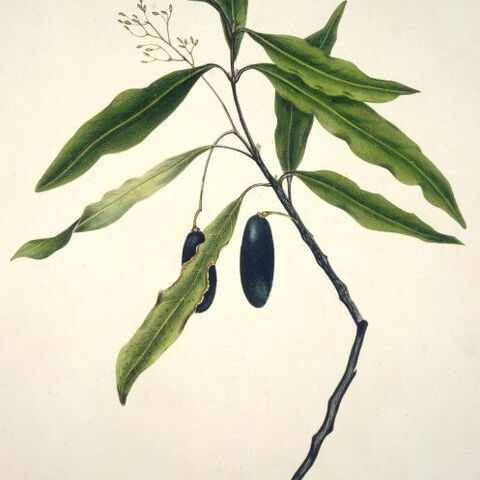Trees and shrubs. Leaves alternate or opposite, the blades penninerved, usually prominently and loosely reticulate above. Inflorescences axillary or subterminal, paniculate, short and few-flowered usually. Involucre none. Flowers perfect. Perianth-tube short, shallow, broadly obconical. Perianth-lobes subequal, or the outer shorter, deciduous. Stamens with filaments bearing anthers with two large cells; those of the outer series large, ovate, flattish, the connectives conspicuously protruding beyond the large introrse cells; stamens of the inner series with nar-rower, thicker anthers, with the connectives protruding beyond the lateral or extrorse-lateral cells, the filaments biglandular. Staminodia large, ovate-acute or triquetrous, shortly stalked or sessile. Gynaecium usually glabrous; ovary sub-globose, short, merging into the thick short obtuse style. Stigma almost incon-spicuous. Fruit usually ellipsoid, obtuse, outer layer thick or thin, usually fleshy, borne on a cylindrical, naked pedicel, scarcely elongated.
Trees, often large. Twigs usually ± sericeous (at least when young), rarely completely glabrescent. Leaves spirally arranged, petiolate; lamina mainly penninerved, midrib raised or flush with upper surface (sometimes slightly depressed in Beilschmiedia volckii ). Inflorescence paniculate, axillary and often pseudoterminal (racemose and axillary in B. oligandra ); bracts small. Flowers bisexual, 3-merous. Tepals 3 + 3. Stamens: anthers 6 introrse, or 6 introrse + 3 extrorse, 2-locular; glands 6, stalked, with stalks usually villous and heads mainly glabrous, or glands absent. Staminodes 0–6. Ovary usually sessile; stigma inconspicuous. Fruit to 70 mm diam.; pedicel not swollen; mesocarp usually fleshy; endocarp thin to thick. Seed to 60 mm diam.; radicle apical or close to apex; cotyledons distinct from one another, uniform in texture.
Trees or shrubs (rarely scandent shrubs fide F.F.N.R.: 58 (1962)). Leaves sometimes subopposite, coriaceous, pinnately nerved. Flowers hermaphrodite in axillary panicles, either dense, sessile and fascicle-like or lax and pedunculate. Perianth-tube short; lobes 6, ± equal. Fertile stamens (6-)9 in (2-)3 rows of 3, those of the first and second rows not glandular and with introrse 2-thecous anthers, those of the third row with usually stipitate glands on either side at base of filaments and extrorse anthers (or reduced to staminodes); staminodes usually present as a fourth row, ovoid, cordate or sagittate, very shortly stipitate. Ovary narrowed into the style. Fruit naked at the base, the perianth-tube deciduous.
Fls perfect; per. deciduous; tube short, segs 6; perfect stamens 9, in 3 series, two outer with introrse anthers and eglandular filaments, third with extrorse anthers and basally biglandular filaments; inner-most series reduced to staminodes. Fr. baccate to drupaceous. Trees and shrubs with alt. to opp. lvs. About 40 mainly tropical spp., the N.Z. ones endemic.
Stamens in 4 whorls, the 2 outer whorls each of 3(4) fertile stamens with anthers dehiscing introrsely; the inner (third) whorl with anthers dehiscing extrorsely or laterally and with a gland on either side at the base of the filaments, or inner (third) whorl anthers sometimes sterile; the innermost (fourth) whorl reduced to 3 staminodes.
Ovary subglobose to narrowly ellipsoid, sessile, ± immersed in the receptacle; narrowed above into a slender style with an obscure stigma.
Leaves alternate, occasionally subopposite towards ends of branches, subsessile or petiolate, papyraceous to coriaceous, pinnately nerved.
Inflorescences terminal and axillary, panicles or racemes or paniculate cymes, few-to many-flowered; bracts ± pubescent, caducous.
Tepals 6(8) in 2 whorls on rim of receptacle, subequal, deciduous.
Fruit a 1-seeded drupe, subglobose to ovoid or ellipsoid, naked.
Flowers hermaphrodite; receptacle shortly tubular or cup-shaped.
Trees or shrubs.

